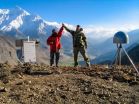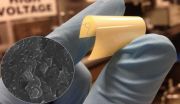Data from Nepal reveals the nature of megathurst earthquakes
2015-08-06
(Press-News.org) This news release is available in Japanese.
As a devastating earthquake ruptured Nepal on April 25, 2015, nearby GPS networks continuously recorded measurements at very close distances. In a new study, these data provide the scientific community with unique insights into megathrust earthquakes, which occur when two tectonic plates converge and one plate is forced underneath the other, and may help hazard assessment teams improve earthquake hazard models. To better understand the sudden and intense changes megathrust earthquakes entail, John Galetzka et al. analyzed data from GPS stations located directly above the Main Himalayan Thrust (MHT) thrust fault (the unzipping of which contributed to the Nepal quake), as well as radar measurements that monitored surface displacements. The data from the 2015 earthquake event clearly indicate a pulse-like rupture that occurred over a mere six seconds, just a fraction of the total 70 second-duration of the earthquake. Measurements reveal a slip pulse 20 kilometers (12.4 miles) wide, with an extremely fast rupture velocity of approximately 3.2km/s (2 miles/second). The smooth onset of the slip pulse limited shaking at frequencies likely to damage regular dwellings, but excited a basin-wide resonance responsible for the collapse of tall structures.
INFORMATION:
Note: For Related Research: Please refer also to the Nature Geoscience press release on the Nature Press Site http://press.nature.com or contact the Nature Press Office team at +44-20-7843-4502 or +1-212-726-9378 or press@nature.com.
Article #15: "Slip pulse and resonance of Kathmandu basin during the 2015 Mw 7.8 Gorkha earthquake, Nepal imaged with geodesy," by J. Galetzka; J.F. Genrich; S. Owen; J.-P. Avouac at California Institute of Technology in Pasadena, CA; D. Melgar at University of California, Berkeley in Berkeley, CA; J. Geng; E.O. Lindsey; X. Xu; Y. Bock at University of California, San Diego in La Jolla, CA; S. Owen; A. Moore at Jet Propulsion Laboratory in Pasadena, CA; J.-P. Avouac at University of Cambridge in Cambridge, UK; L.B. Adhikari; P. Shrestha; B. Koirala; U. Gautam; M. Bhatterai; R. Gupta; T. Kandel; C. Timsina; S.N. Sapkota; S. Rajaure; N. Maharjan at Department of Mines and Geology in Kathmandu, Nepal; B.N. Upreti at Nepal Academy of Science and Technology (NAST) in Patan, Nepal; B. Pratt-Sitaula; W. Szeliga at Central Washington University in Ellensburg, WA; T.N. Bhattarai; B.P. Sitaula at Tribhuvan University in Kathmandu, Nepal; K.W. Hudnut at U.S. Geological Survey in Pasadena, CA; J. Galetzka; J. Normandeau; M. Fend at UNAVCO Inc. in Boulder, CO; M. Flouzat; L. Bollinger at French Alternative Energies and Atomic Energy Commission (CEA) in Arpajon, France.
ELSE PRESS RELEASES FROM THIS DATE:
2015-08-06
This news release is available in Japanese.
In the face of the recent Ebola outbreak, some good news emerges: a preclinical study testing the efficacy of the Ebola vaccine VSV-EBOV against the newly emerged West African Ebola strain shows complete protection when administered seven days before infection in nonhuman primates, and partial protection when administered three days before infection. The positive results of this study further reveal the mechanisms by which an effective immune response is mounted against the Ebola virus, aspects of which have been unclear. ...
2015-08-06
Darwinian selection can be used to evolve robot controllers able to efficiently self-organize their tasks. Taking inspiration from the way in which ants organise their work and divide up tasks, Eliseo Ferrante and colleagues evolved complex robot behaviors using artificial evolution and detailed robotics simulations.
Just like social insects such as ants, bees or termites teams of robots display a self-organized division of labor in which the different robots automatically specialized into carrying out different subtasks in the group, says new research publishing in PLOS ...
2015-08-06
Big data sets are important tools of modern science. Mining for correlations between millions of pieces of information can reveal vital relationships or predict future outcomes, such as risk factors for a disease or structures of new chemical compounds.
These mining operations are not without risk, however. Researchers can have a tough time telling when they have unearthed a nugget of truth, or what amounts to fool's gold: a correlation that seems to have predictive value but actually does not, as it results just from random chance.
A research team that bridges academia ...
2015-08-06
Autopsies of nearly every patient with the lethal neurodegenerative disorder amyotrophic lateral sclerosis (ALS), and many with frontotemporal dementia (FTD), show pathologists telltale clumps of a protein called TDP-43. Now, working with mouse and human cells, Johns Hopkins researchers report they have discovered the normal role of TDP-43 in cells and why its abnormal accumulation may cause disease.
In an article published Aug. 7 in Science, the researchers say TDP-43 is normally responsible for keeping unwanted stretches of the genetic material RNA, called cryptic ...
2015-08-06
For more than 20 years, Caltech geologist Jean-Philippe Avouac has collaborated with the Department of Mines and Geology of Nepal to study the Himalayas--the most active, above-water mountain range on Earth--to learn more about the processes that build mountains and trigger earthquakes. Over that period, he and his colleagues have installed a network of GPS stations in Nepal that allows them to monitor the way Earth's crust moves during and in between earthquakes. So when he heard on April 25 that a magnitude 7.8 earthquake had struck near Gorkha, Nepal, not far from Kathmandu, ...
2015-08-06
Case Western Reserve scientists may have uncovered a molecular mechanism that sets into motion dangerous infection in the feet and hands often occurring with uncontrolled diabetes. It appears that high blood sugar unleashes destructive molecules that interfere with the body's natural infection-control defenses.
The harmful molecules -- dicarbonyls -- are breakdown products of glucose that interfere with infection-controlling antimicrobial peptides known as beta-defensins. The Case Western Reserve team discovered how two dicarbonyls -- methylglyoxal (MGO) and glyoxal (GO) ...
2015-08-06
ROSEMONT, Ill.--According to a new study in the Journal of the American Academy of Orthopaedic Surgeons (JAAOS), imaging studies necessary to diagnose traumatic injuries sustained by pregnant women are safe when used properly.
During pregnancy, approximately 5 to 8 percent of women sustain traumatic injuries, including fractures and muscle tears. To help evaluate and manage these injuries, orthopaedic surgeons often recommend radiographs and other imaging studies. "While care should be taken to protect the fetus from exposure, most diagnostic studies are generally safe, ...
2015-08-06
Women experience more emotional pain following a breakup, but they also more fully recover, according to new research from Binghamton University.
Researchers from Binghamton University and University College London asked 5,705 participants in 96 countries to rate the emotional and physical pain of a breakup on a scale of one (none) to 10 (unbearable). They found that women tend to be more negatively affected by breakups, reporting higher levels of both physical and emotional pain. Women averaged 6.84 in terms of emotional anguish versus 6.58 in men. In terms of physical ...
2015-08-06
PITTSBURGH-- In the era of launching Kickstarter campaigns to pay for just about anything, Carnegie Mellon University ethicists warn that the trend of patients funding their own clinical trials may do more harm than good.
CMU's Danielle Wenner and Alex John London and McGill University's Jonathan Kimmelman co-wrote a column in Cell Stem Cell outlining how patient-funded trials may seem like a beneficial new way to involve more patients in research and establish new funding opportunities, but instead they threaten scientific rigor, relevance, efficiency and fairness.
"Patient-funded ...
2015-08-06
Easily manufactured, low cost, lightweight, flexible dielectric polymers that can operate at high temperatures may be the solution to energy storage and power conversion in electric vehicles and other high temperature applications, according to a team of Penn State engineers.
"Ceramics are usually the choice for energy storage dielectrics for high temperature applications, but they are heavy, weight is a consideration and they are often also brittle," said Qing Wang, professor of materials science and engineering, Penn State. "Polymers have a low working temperature and ...
LAST 30 PRESS RELEASES:
[Press-News.org] Data from Nepal reveals the nature of megathurst earthquakes

